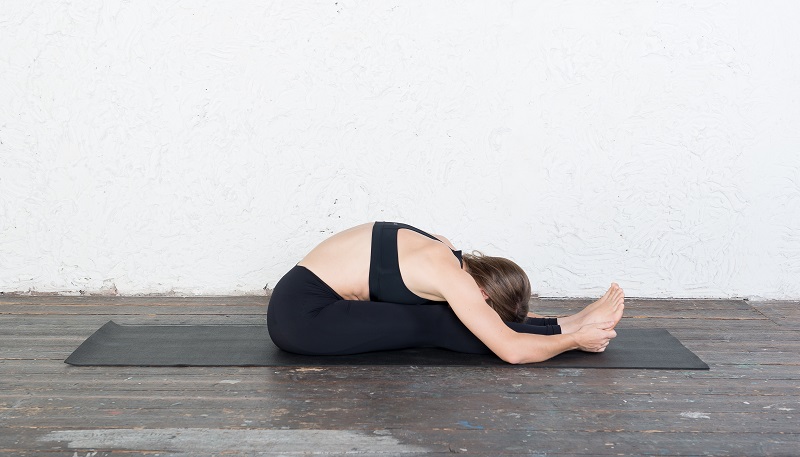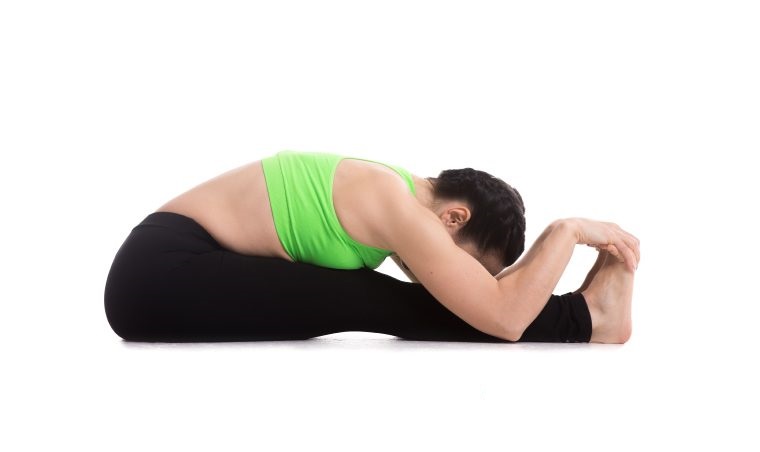ALL >> Fitness >> View Article
Seated Forward Bend Pose For Paschimottanasana
Seated forward bend pose for PASCHIMOTTANASANAThe Paschimottanasana is a seated forward bending asana in hatha yoga
and modern yoga as exercise. As the name suggests, it is done in a
seated position by folding the upper body over the lower body and gently
bringing the head and arms close to the thighs, calves or knees.
The name comes from the Sanskrit words, “Pashchima” means west or the back of the body, “Uttana” means intense stretch or straight or extended, and “Asana” means posture or seat.
The Paschimottanasana or the seated forward bend pose is described in the 15th-century Hatha Yoga Pradipika.

PREPARATORY ...
... POSES
As you all know the significance of various yoga asanas and the science behind them. Likewise, the Paschimottanasana
or the seated forward bend pose also follows the same principle. A few
of the preparatory poses can be worked at before the main pose, they are
as follows:
Baddha Konasana or Bound Angle PoseBaddha Konasana Uttanasana or Bound Angle Forward Bend PoseBalasana or Child PoseJanu Sirasana or Head to Knee Pose
Above are the most common preparatory poses and stretches you will
need before practising the seated forward bend pose for
Paschimottanasana. Remember that these preparatory poses may vary
depending on your level.
HOW DO THE PASCHIMOTTANASANA OR THE SEATED FORWARD BEND POSE?
The following steps need to be followed while practicing the
Paschimottanasana or the seated forward bend pose to avail the mental
and physical health benefits of the Paschimottanasana or the seated
forward bend pose:
Begin with the seated position, sit with your legs together or hip-width apart, and straight in front of you.Ensure that you are sitting high up on your sitting bones.Inhale deeply and reach with both arms toward the ceiling, arms parallel to your ears.While exhaling, keep on reaching forward, and bend forward, reaching with your hands toward your toes.Now draw your nose to your knees. If you are unable to reach your toes, you can hold your ankles, shins, or even your knees. Rest your elbows on the floor.Hold the pose for some time.Release the pose, breathe in and slowly roll up, vertebra by vertebra, shoulders and head coming up last.
If your lower back is tight, you can open your legs hip-width apart,And for tight hamstrings, you can bend your knees and support them with a block or folded blanket.
BEGINNER’S TIPS FOR SEATED FORWARD BEND POSE PASCHIMOTTANASANA
Lengthen your spine and avoid curving or hunching at all times. Make
sure that you look straight, instead of down, as this will help keep
your spine erect. Pull your stomach in and engage your core before you bend forward. Your knees must be straight throughout the practice. If you can’t
bring your head down without bending your knees, then bend your knees
just a little bit and bring your head down as far as is comfortable and
hold your knees or calf muscles. Ensure that your whole body should be relaxed in the final position and your breathing should be deep.
PRECAUTIONS AND CONTRAINDICATIONS
Do not practice the Paschimottanasana or the seated forward bend pose, if you have any of the following health issues:-
Abdominal issues such as diarrhoea, ulcer, menstrual pains or any recent surgery.Lower back and spinal issues such as chronic pain, herniated disc, sciatica or SI-joint instability.Hypertension as it keeps your head elevated above heart level.
VARIATIONS OF THE PASCHIMOTTANASANA OR SEATED FORWARD BEND POSE
There are numerous variations of the Paschimottanasana or the seated
forward bend pose. You can try these poses individually or use them to
create a sequence, and enjoy the miraculous benefits of the
Paschimottanasana or the seated forward bend pose.
The significant variations of the Paschimottanasana or the seated forward bend pose are mentioned here:
Urdhva Mukha Paschimottanasana is a balancing form of the pose, in which your legs and hands point upwards.Parivritta Paschimottanasana is the reversed or
twisted form of the pose, in which your body is twisted to one side and
your hands are reversed so that if your body is turned to the left, your
right-hand grasp your left foot, the right elbow is over your left
knee, and your left-hand grasps your right foot.Trianga Mukhaikapada Paschimottanasana is another therapeutic pose in which one leg is bent as in Virasana.Ardha Baddha Padma Paschimottanasana is also a significant variation in which one leg is crossed over the other as in Padmasana.
BENEFITS OF THE PASCHIMOTTANASANA OR SEATED FORWARD BEND
Let’s take a look at the mental and physical health benefits of the Paschimottanasana or the seated forward bend pose:
It stimulates your Solar Plexus Chakra.It stimulates and balances the functions of your stomach, gallbladder, liver, spleen, and pancreas.It improves the digestive tract.It eliminates toxins from your body.It improves peristalsis and combats constipation through the squeeze-and-release effect.It regulates blood sugar levels, by regulating pancreas function.It helps to balance the menstrual cycle.It regulates blood circulation to the pelvic region.It slightly increases blood pressure toward your head and has a calming effect on the brain and mind.It aids in relieving stress and anxiety.It stretches your entire spine, especially the lumbar and thoracic spine, and enhances blood circulation in the back region.It tones your spinal nerves.It improves the flexibility of the lower back, hips, and hamstrings.It massages and tones your abdominal and pelvic organs.It tones your shoulders as well.

THE BOTTOM LINE
The Paschimottanasana or the seated forward bend pose is one of the
dynamic poses that promote health and harmony. Daily practice of the
Paschimottanasana or Seated Forward Bend or Seated Forward Fold keeps
your spine elastic, your joints mobile, your organs healthy and your
nervous system invigorated.
So get started on this asana at home, at the office, or any other
calm place to the extent your body can, and don’t worry about achieving
the perfect pose.
If you are keen to learn more about the health benefits of the
Paschimottanasana or Seated Forward Bend pose or any other yoga poses,
you can visit your website.
Stay healthy, stay strong and get the best out of life!
Keep reading.
Visit: Yoga Teacher Training In Rishikesh | Yoga Teacher Training In India
Add Comment
Fitness Articles
1. Jaggery Vs Sugar Vs Stevia: What’s Best For Diabetes?Author: FFD
2. Almond Milk Vs Cow Milk – The Truth Every Diabetic Should Know
Author: FFD
3. Global Oncology Adjuvants Market Analysis By Size, Share, Key Drivers, Growth Opportunities And Global Trends 2025-2034
Author: seo
4. Is Bottle Gourd Safe For Diabetes?
Author: FFD
5. What Is Tirzepatide As Compared With Semaglutide For The Treatment Of Obesity?
Author: eliasmarc
6. Is Coconut Milk Safe For Sugar Patients?
Author: FFD
7. Non Surgical Hair Restoration Methods For A Better Hair Care
Author: anil jain
8. Are Pumpkin Seeds Safe For Diabetics?
Author: FFD
9. Travancore Ayurveda: Authentic Healing For Modern Lifestyle Disorders
Author: Travancore Ayurveda
10. Does Khapli Wheat Increase Blood Sugar? Understanding Its Role In Diabetes Management
Author: FFD
11. A Beginner's Guide To Yoga Teacher Certification Bali: What You Should Know
Author: Hartono Agung
12. A Beginner's Guide To 200 Hour Yoga Teacher Training In Bali
Author: Hartono Agung
13. Green Smoothie For Diabetes Patients
Author: FFD
14. Ozempic For Weight Loss: Risks & Side Effects
Author: eliasmarc
15. What Are Top 10 Vegetables For Diabetics?
Author: FFD








